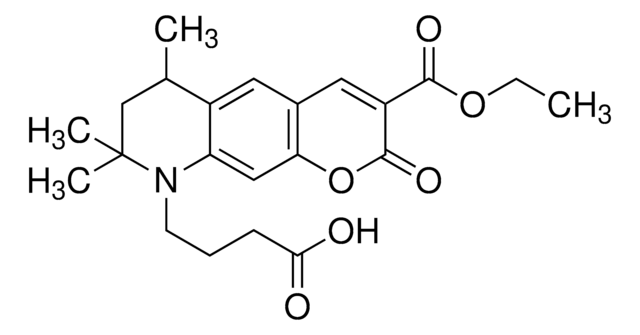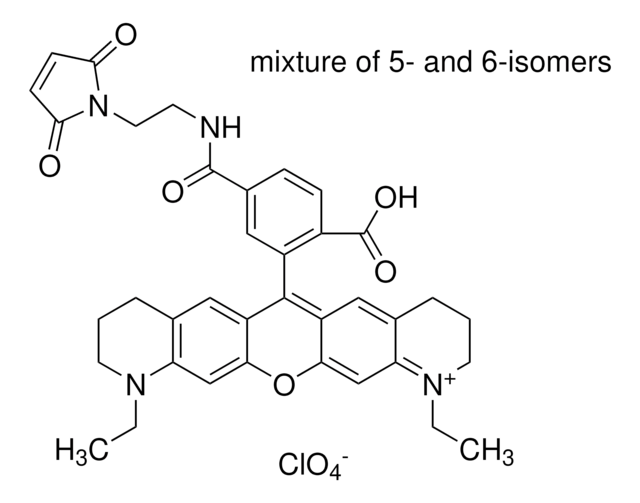75784
Atto 565
BioReagent, suitable for fluorescence
Iniciar sesiónpara Ver la Fijación de precios por contrato y de la organización
About This Item
Fórmula empírica (notación de Hill):
C31H31ClN2O9
Peso molecular:
611.04
MDL number:
UNSPSC Code:
12352108
NACRES:
NA.32
Productos recomendados
product line
BioReagent
assay
≥90.0% (HPLC)
form
powder
manufacturer/tradename
ATTO-TEC GmbH
λ
in ethanol (with 0.1% trifluoroacetic acid)
UV absorption
λ: 562.0-568.0 nm Amax
suitability
suitable for fluorescence
storage temp.
−20°C
¿Está buscando productos similares? Visita Guía de comparación de productos
Application
Atto-Farbstoffe wurden entwickelt, um den höchsten Ansprüchen an Sensitivität zu genügen. Eine einmalige Kombination von Vorteilen macht sie zu bevorzugten Werkzeugen für alle Arten von Markierungen . Und einige Eigenschaften bieten besondere Vorzüge in der Einzelmoleküldetektion. Atto-Farbstoffe basieren auf rigiden Strukturen und zeigen keine cis-trans-isomerisierung. Letztere vermindert bei vielen anderen Fluorophoren die Helligkeit des Signals und führt zur Beeinflussbarkeit durch Umweltbedingungen, bspw. zu spektralen Verschiebungen bei der Konjugation.
Atto 565 hat eine molekulare Absorption von 120.000 und einen QY von 92% in Wasser (97% in Ethanol). Die Abklingzeit beträgt 3.4 ns.
Atto 565 hat eine molekulare Absorption von 120.000 und einen QY von 92% in Wasser (97% in Ethanol). Die Abklingzeit beträgt 3.4 ns.
Specific and stable fluorescence labeling of histidine-tagged proteins
Legal Information
This product is for Research use only. In case of intended commercialization, please contact the IP-holder (ATTO-TEC GmbH, Germany) for licensing.
Storage Class
11 - Combustible Solids
wgk_germany
WGK 3
flash_point_f
Not applicable
flash_point_c
Not applicable
ppe
Eyeshields, Gloves, type N95 (US)
Elija entre una de las versiones más recientes:
¿Ya tiene este producto?
Encuentre la documentación para los productos que ha comprado recientemente en la Biblioteca de documentos.
Los clientes también vieron
Suman Lata et al.
Journal of the American Chemical Society, 128(7), 2365-2372 (2006-02-16)
Labeling of proteins with fluorescent dyes offers powerful means for monitoring protein interactions in vitro and in live cells. Only a few techniques for noncovalent fluorescence labeling with well-defined localization of the attached dye are currently available. Here, we present
Łukasz Krzemiński et al.
Journal of the American Chemical Society, 133(38), 15085-15093 (2011-08-26)
A combined fluorescence and electrochemical method is described that is used to simultaneously monitor the type-1 copper oxidation state and the nitrite turnover rate of a nitrite reductase (NiR) from Alcaligenes faecalis S-6. The catalytic activity of NiR is measured
Marie-Luise Humpert et al.
Proteomics, 12(12), 1938-1948 (2012-05-25)
PTMs of extracellular domains of membrane proteins can influence antibody binding and give rise to ambivalent results. Best proof of protein expression is the use of complementary methods to provide unequivocal evidence. CXCR7, a member of the atypical chemokine receptor
Takao Nakata et al.
The Journal of cell biology, 194(2), 245-255 (2011-07-20)
Polarized transport in neurons is fundamental for the formation of neuronal circuitry. A motor domain-containing truncated KIF5 (a kinesin-1) recognizes axonal microtubules, which are enriched in EB1 binding sites, and selectively accumulates at the tips of axons. However, it remains
Sebastian van de Linde et al.
Photochemical & photobiological sciences : Official journal of the European Photochemistry Association and the European Society for Photobiology, 8(4), 465-469 (2009-04-02)
We introduce a general approach for multicolor subdiffraction-resolution fluorescence imaging based on photoswitching of standard organic fluorophores. Photoswitching of ordinary fluorophores such as ATTO520, ATTO565, ATTO655, ATTO680, or ATTO700, i.e. the reversible transition from a fluorescent to a nonfluorescent state
Nuestro equipo de científicos tiene experiencia en todas las áreas de investigación: Ciencias de la vida, Ciencia de los materiales, Síntesis química, Cromatografía, Analítica y muchas otras.
Póngase en contacto con el Servicio técnico



